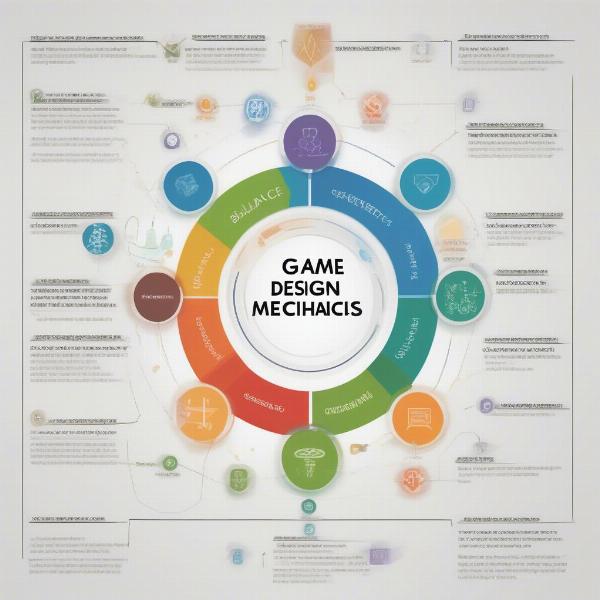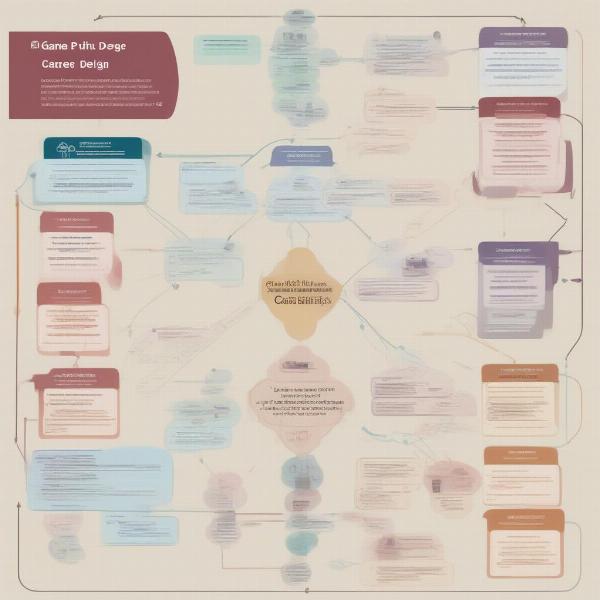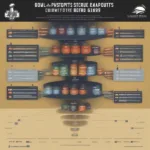Game design is a captivating field, blending creativity and technical skills to craft immersive experiences. Whether you dream of building expansive worlds or designing intricate gameplay mechanics, learning game design is a journey of exploration and constant learning. This guide will provide you with a roadmap to navigate the exciting world of game design, offering practical tips and valuable resources to help you turn your passion into a reality.
Similar to choosing the right tools for game development, selecting a learning path that suits your style and goals is essential. So, let’s dive into the core principles and actionable steps to kickstart your game design journey.
Understanding the Fundamentals of Game Design
Before jumping into complex software or coding languages, it’s crucial to grasp the core principles of game design. These foundational concepts form the bedrock of every successful game. Think of it like building a house – you need a solid foundation before you can start adding walls and a roof.
- Core Mechanics: These are the basic actions players can perform in your game, such as jumping, shooting, or solving puzzles. Strong core mechanics are intuitive, engaging, and offer a sense of satisfaction.
- Game Rules: Rules define the boundaries and possibilities within your game world. They dictate how players interact with the environment and each other.
- Game Balance: A well-balanced game ensures fairness and prevents certain elements from becoming overpowered or irrelevant. This involves careful tweaking and testing throughout the development process.
- Player Experience (UX): Consider how players will interact with your game. Is the interface user-friendly? Does the gameplay flow smoothly? A positive UX is crucial for player retention.
- Level Design: Creating compelling and challenging levels is an art form in itself. Effective level design guides players through the game’s narrative and provides opportunities for meaningful gameplay.
Understanding these fundamentals is like learning the grammar of a new language. Once you master these basics, you can start expressing yourself creatively through game design.
 Game Design Fundamentals Diagram
Game Design Fundamentals Diagram
Choosing Your Learning Path: Formal Education vs. Self-Learning
There are two primary paths to learning game design: formal education and self-learning. Both have their advantages and disadvantages. Formal education provides structured learning, expert guidance, and networking opportunities. Self-learning, on the other hand, offers flexibility, affordability, and allows you to learn at your own pace.
Formal Education: Game Design Degrees and Courses
Universities and colleges offer dedicated game design programs, ranging from bachelor’s to master’s degrees. These programs provide a comprehensive curriculum covering various aspects of game development, including programming, art, and design principles.
- Pros: Structured learning, industry connections, portfolio development, specialized knowledge.
- Cons: Costly, time-consuming, may not cover all areas of interest.
Self-Learning: Online Resources and Independent Study
If you prefer a more flexible and affordable approach, self-learning is an excellent option. Numerous online resources, tutorials, and communities are available to help you learn game design at your own pace. This path requires self-discipline and motivation, but it can be incredibly rewarding.
- Pros: Affordable, flexible, personalized learning, access to a wide range of resources.
- Cons: Requires self-discipline, lack of structured feedback, can be challenging to build a portfolio.
Choosing the right path depends on your learning style, budget, and career goals. Some individuals thrive in a structured academic environment, while others prefer the freedom of self-directed learning.
Thinking about becoming a writer for video games could be a great alternative career path. Find out more about how to become a writer for video games through our dedicated guide.
Mastering Essential Tools and Software
Game design involves more than just coming up with great ideas. You’ll need to learn how to use various tools and software to bring your visions to life.
Game Engines: Your Creative Sandbox
Game engines are software frameworks that provide the tools and functionalities needed to create games. They handle everything from graphics rendering and physics simulations to audio management and input controls. Popular game engines include:
- Unity: A versatile engine known for its user-friendly interface and cross-platform compatibility. It’s a great choice for beginners. For those curious, we have a guide on which game engine is best for beginners.
- Unreal Engine: A powerful engine used to create stunning visuals and complex games. It has a steeper learning curve but offers immense potential.
- Godot Engine: A free and open-source engine that’s gaining popularity for its ease of use and flexibility.
Choosing the right game engine depends on your project’s scope, your technical skills, and your personal preferences.
Digital Art and Design Software
Creating visually appealing assets is essential for immersive game experiences. Familiarizing yourself with digital art and design software will allow you to create characters, environments, and user interfaces that enhance your game’s world.
- Adobe Photoshop: An industry-standard image editing software used for creating textures, concept art, and UI elements.
- Blender: A powerful 3D modeling and animation software perfect for creating characters, props, and environments.
Building Your Game Design Portfolio
A strong portfolio is essential for showcasing your skills and landing job opportunities in the game industry. Your portfolio should demonstrate your creativity, technical abilities, and problem-solving skills.
- Start Small: Begin with simple projects to practice your skills and build a foundation.
- Focus on Quality: Prioritize quality over quantity. A few well-polished projects are more impactful than a large collection of unfinished games.
- Iterate and Improve: Don’t be afraid to revisit your projects and make improvements. Learning is an ongoing process.
- Showcase Your Versatility: Include a variety of projects that demonstrate your range of skills and interests.
- Get Feedback: Share your work with others and solicit feedback. Constructive criticism can help you identify areas for improvement.
Building a portfolio is a journey, not a destination. Continuously refine your skills and add new projects to showcase your growth and development.
You can even learn how to make a battlegrounds game and add it to your portfolio. Check out our detailed guide!
Networking and Community Engagement
Connecting with other game designers and industry professionals is invaluable for learning and career growth. Networking provides opportunities for collaboration, mentorship, and job opportunities.
- Attend Game Jams: Game jams are events where developers come together to create games within a limited timeframe. They’re a great way to meet other developers, learn new skills, and build your portfolio.
- Join Online Communities: Engage in online forums, Discord servers, and social media groups dedicated to game development.
- Attend Industry Events: Conferences and workshops offer opportunities to learn from experts, network with professionals, and stay up-to-date on industry trends.
FAQs About Learning Game Design
Here are some frequently asked questions about learning game design:
- What skills are needed for game design? Creativity, problem-solving, communication, technical proficiency, and a passion for games.
- How long does it take to learn game design? It depends on your learning path and dedication. It can take anywhere from a few months to several years to develop proficiency.
- Is coding required for game design? While not always essential, learning basic coding can be beneficial, especially for independent game developers.
- How do I get started with game design? Start with the fundamentals, choose a learning path, and practice regularly.
- What are some common mistakes to avoid? Trying to do too much too soon, neglecting the fundamentals, and not seeking feedback.
- How can I improve my game design skills? Practice consistently, seek feedback, study successful games, and stay up-to-date on industry trends.
- What are the career opportunities in game design? Game designer, level designer, narrative designer, UX designer, and many more.
 Game Design Career Paths
Game Design Career Paths
Conclusion: Embark on Your Game Design Adventure
Learning How To Learn Game Design is a continuous journey filled with challenges and rewards. By embracing the fundamentals, choosing a suitable learning path, mastering essential tools, and actively engaging with the community, you can transform your passion into a fulfilling career. Remember to stay curious, persistent, and never stop learning. The world of game design is constantly evolving, and there’s always something new to discover. So, take the first step, unleash your creativity, and start building the games of your dreams. Don’t forget to share this guide if you found it helpful! Are you ready to embark on your game design adventure?
If you’re a gamer who uses Discord, you might find our guide on how to show what game you’re playing on Discord quite useful. Give it a read!

